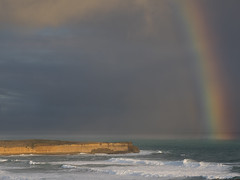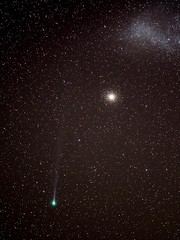Last month I had the opportunity to head down top the coast and find a nice spot to shoot the Milky Way with Jupiter, Mars and Saturn nicely lined up with it.
It was not an easy shot to achieve – after initial planning during daylight hours to find the right location which was under the ocean at high tide, I had to wait until low tide coincided with the rising Milky Way, then walk about 500m amongst the rock pools in the dark.
My first attempt at 10pm I had to abort due to clouds coming over and I thought the last chance for the month was going to be gone.
At 1.30am though the clouds had cleared and although the tide was now rising and there was increased risk of rogue waves washing me off the rock platform, I decided to get back in the car and drive to the location and try it out.
I used the Olympus OM-D E-M1 Mark II Micro Four Thirds camera matched with the lovely Olympus micro ZD 8mm f/1.8 fisheye lens which is a nice lens for Milky Way shots as it renders stars well, as a very wide field of view which means one can use longer exposures without obvious star trailing, and the f/1.8 aperture means one can shoot comfortably at ISO 1600-3200. The ultra wide field of view avoids the painstaking task of shooting a dozen different shots and stitching them together.
I lit the foreground structures with my LED Lenser head torch on its low spot setting.
Here is my single shot image which has had some LR post-processing – 8mm f/1.8 fisheye at f/1.8, 15 secs, ISO 3200:
Note that the top left bright “star” is Jupiter, the top right constellations are Crux (Southern Cross) and the Pointers of Centaurus. The two bright “stars” below the Milky Way core are Saturn, and the brighter Mars. The bright orange star near Jupiter is Antares, the brightest star of Scorpio. I love that the rock formation to the right looks a bit like the map of Australia. The green to bottom left is some light pollution of a nearby town where I was staying and residual sea fog / cloud – perhaps I left Netflix on with Stranger Things running!
I was also keen to see how the new Olympus Viewer defishing function would work with star shapes (I could have used the new in-camera defishing function but I wanted to work with RAW files not jpegs) – unfortunately at the ultra wide setting – the edge stars were severely stretched – this may need a bit more experimentation to mitigate, but at least we get a straight horizon – for me though I would prefer nice star shapes and a curved horizon.
I have posted previous blogs of Milky Way shots taken with the Olympus 8mm f/1.8 fisheye lens:
-
Milky Way astroscape – Olympus OM-D with fisheye vs Sony a7II full frame with Canon TSE 17mm tilt shift lens on the Great Ocean Road
-
Planetary alignment and Milky Way over Australia’s iconic Craig’s Hut in Victoria’s Alps – Olympus f/1.8 fisheye comes to the fore












